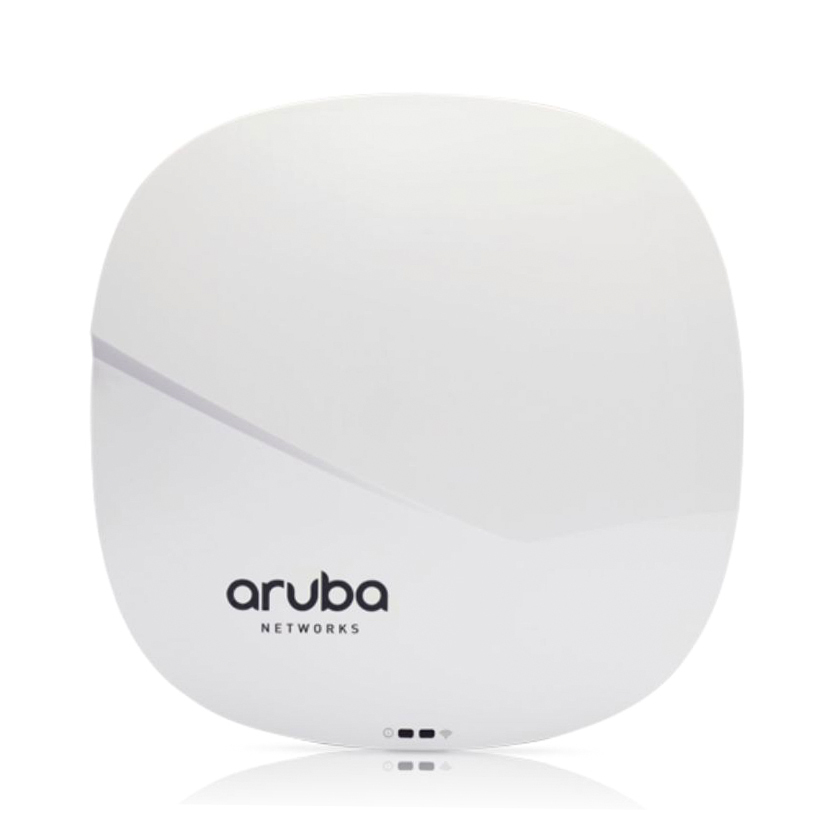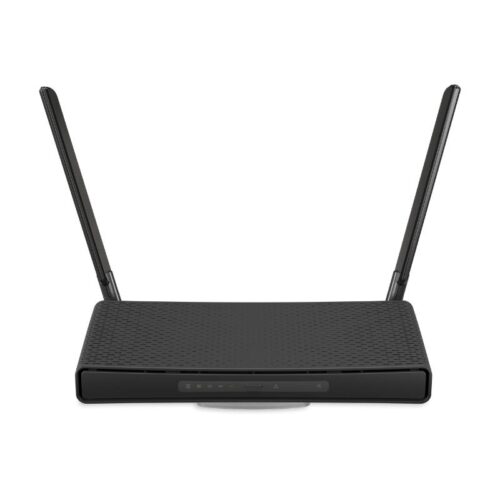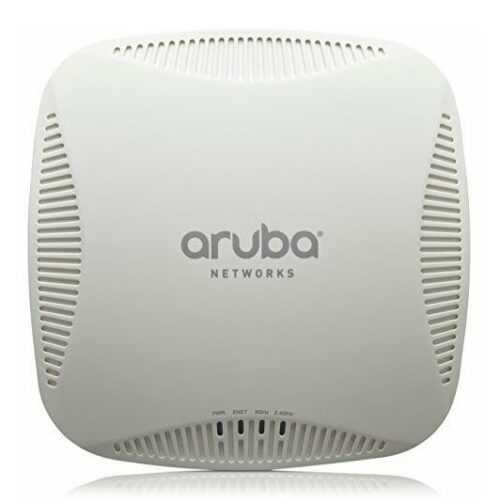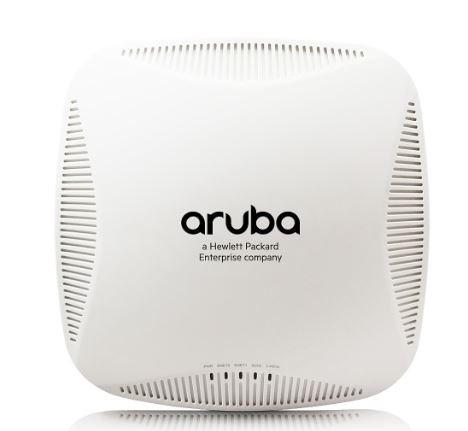| Model |
Wireless Access Point Aruba AP-345
|
| WI-FI Radio Specifications |
- AP type: Indoor, dual radio, 5 GHz 802.11ac and 2.4 GHz 802.11n 4x4 MIMO.
- Software-configurable dual radio supports 5 GHz (Radio 0) and 2.4 GHz (Radio 1).
- Four spatial stream SU-MIMO for up to 1,733 Mbps wireless data rate to a single client device.
- Three spatial stream MU-MIMO for up to 1,300 Mbps wireless data rate to up to three MU-MIMO capable client devices simultaneously.
- Support for up to 256 associated client devices per radio, and up to 16 BSSIDs per radio.
- Supported frequency bands (country-specific restrictions apply):
- 2.400 to 2.4835 GHz
- 5.150 to 5.250 GHz
- 5.250 to 5.350 GHz
- 5.470 to 5.725 GHz
- 5.725 to 5.850 GHz
- Available channels: Dependent on configured regulatory domain.
- Dynamic frequency selection (DFS) optimizes the use of available RF spectrum.
- Supported radio technologies:
- 802.11b: Direct-sequence spread-spectrum (DSSS)
- 802.11a/g/n/ac: Orthogonal frequency-division multiplexing (OFDM)
- Supported modulation types:
- 802.11b: BPSK, QPSK, CCK
- 802.11a/g/n/ac: BPSK, QPSK, 16-QAM, 64-QAM, 256-QAM
- Transmit power: Configurable in increments of 0.5 dBm
- Maximum (aggregate, conducted total) transmit power (limited by local regulatory requirements):
- 2.4 GHz band: +24 dBm (18 dBm per chain)
- 5 GHz band: +24 dBm (18 dBm per chain)
- Note: conducted transmit power levels exclude antenna gain. For total (EIRP) transmit power, add antenna gain
- Advanced Cellular Coexistence (ACC) minimizes interference from cellular networks.
- Maximum ratio combining (MRC) for improved receiver performance.
- Cyclic delay/shift diversity (CDD/CSD) for improved downlink RF performance.
- Short guard interval for 20-MHz, 40-MHz and 80-MHz channels.
- Space-time block coding (STBC) for increased range and improved reception.
- Low-density parity check (LDPC) for high-efficiency error correction and increased throughput.
- Transmit beamforming (TxBF) for increased signal reliability and range.
- Supported data rates (Mbps):
- 802.11b: 1, 2, 5.5, 11
- 802.11a/g: 6, 9, 12, 18, 24, 36, 48, 54
- 802.11n: 6.5 to 450 (MCS0 to MCS23)
- 802.11ac: 6.5 to 1,733 (MCS0 to MCS9, NSS = 1 to 4)
- 802.11n high-throughput (HT) support: HT 20/40
- 802.11ac very high throughput (VHT) support: VHT 20/40/80
- 802.11n/ac packet aggregation: A-MPDU, A-MSDU
|
| Antennas |
- Eight integrated downtilt omni-directional antennas for 4x4 MIMO with maximum antenna gain of 4.0 dBi in 2.4 GHz and 4.7 dBi in 5 GHz. Built-in antennas are optimized for horizontal ceiling-mounted orientation of the AP. The downtilt angle for maximum gain is ~ 30 degrees. Combining the patterns of each of the antennas of the MIMO radios, the peak gain of the effective per-antenna pattern is 2.7dBi in 2.4GHz and 2.9dBi in 5GHz.
|
| Other Interface |
- Two 10/100/1000BASE-T Ethernet network interfaces (RJ-45)
- Auto-sensing link speed and MDI/MDX
- Load balancing support to achieve platform throughput greater than 1 Gbps
- 802.3az Energy Efficient Ethernet (EEE)
- PoE-PD: 48 Vdc (nominal) 802.3af or 802.3at PoE
- DC power interface, accepts 2.1/5.5-mm center-positive circular plug with 9.5-mm length
- USB 2.0 host interface (Type A connector)
- Bluetooth Low Energy (BLE) radio
- Up to 4dBm transmit power (class 2) and -94dBm receive sensitivity
- Integrated antenna, -5dBi gain (30 degree downtilt)
- Can be disabled with configuration
- Visual indicators (tri-color LEDs): For system and radio status
- Reset button: Factory reset (during device power up)
- Serial console interface (RJ-45)
- Kensington security slot
|
| Power |
- Maximum (worst-case) power consumption: 20W (802.3at PoE), 13.5W (802.3af PoE) or 18.5W (DC)
- Excludes power consumed by external USB device (and internal overhead); this could add up to 6W (POE) or 5.5W (DC) for 5W/1A USB device
- Maximum (worst-case) power consumption in idle mode: 8W (PoE) or 7W (DC).
- Direct DC source: 48Vdc nominal, +/- 5%.
- Power over Ethernet (PoE): 12 Vdc (nominal) 802.3af/802.3at compliant source
- Unrestricted functionality with 802.3at PoE
- Power-save mode with reduced functionality from 802.3af PoE
- USB port disabled
- Second Ethernet port disabled
- 2.4 GHz radio in 1x1:1 mode
- Power sources sold separately
- When both power sources are available, DC power takes priority
|
| Environmental & Reliability
|
- Operating:
- Temperature: 0° C to +50° C (+32° F to +122° F)
- Humidity: 5% to 93% non-condensing
- Storage and transportation:
- Temperature: -40° C to +70° C (-40° F to +158° F)
|
| Certifications |
- CB Scheme Safety, cTUVus
- UL2043 plenum rating
- Wi-Fi Alliance (WFA) certified 802.11a/b/g/n/ac
- Bluetooth SIG interoperability certification
- Passpoint® (Release 2) with ArubaOS and Instant 8.3+
|
| Minimum Software Versions |
|
| Mechanical |
- Dimensions/weight (unit, excluding mount accessories):
- 203 mm (W) x 203 mm (D) x 57 mm (H), 8.0” (W) x 8.0” (D) x 2.2” (H)
- 950 g/34 oz
- Dimensions/weight (shipping):
- 315 mm (W) x 265 mm (D) x 100 mm (H), 12.4” (W) x 10.4” (D) x 3.9” (H)
- 1,350 g/48 oz
|




 Bảo hành 12 tháng
Bảo hành 12 tháng


 Cài đặt phần mềm.
Cài đặt phần mềm. 


đánh giá nào
Chưa có đánh giá nào.